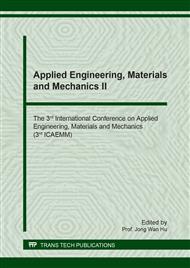[1]
P. Ma, D. G. Hristova-Bogaerds, J. G. P. Goossens, A. B. Spoelstra, Y. Zhang and P. J. Lemsha, Toughening of poly(lactic acid) by ethylene-co-vinyl acetate copolymer with different vinyl acetate contents, Eur. Polym. J. 48(1) (2012) 146-154.
DOI: 10.1016/j.eurpolymj.2011.10.015
Google Scholar
[2]
A. K. Mohapatra, S. Mohanty and S. K. Nayak, Study of thermo-mechanical morphological behavior of biodegradable PLA/PBAT/layered silicate blend nanocomposites, J. Polym. Environ. 22(3) (2014) 398-408.
DOI: 10.1007/s10924-014-0639-x
Google Scholar
[3]
W. Chinsirikul, J. Rojsatean, B. Hararak, N. Kerddonfag, A. Aontee, K. Jaieau, P. Kumsang and C. Sripethdee, Flexible and tough poly(lactic acid) films for packaging applications: property and processability improvement by effective reactive blending, Packag. Technol. Sci. 28(8) (2015).
DOI: 10.1002/pts.2141
Google Scholar
[4]
J. P. Chimanowsky, I. L. Soares, L. Luetkmeyer, M. I. B. Tavares, Preparation of high-impact polystyrene nanocomposites with organoclay by melt intercalation and characterization by low-field nuclear magnetic resonance, Chem. Eng. Process. 77 (2014).
DOI: 10.1016/j.cep.2013.11.012
Google Scholar
[5]
C. S. Wu, Process, characterization and biodegradability of aliphatic aromatic polyester/sisal fiber composites, J. Polym. Environ. 19(3) (2011) 706-713.
DOI: 10.1007/s10924-011-0318-0
Google Scholar
[6]
E. Petinakis, L. Yu, G. Edward, K. Dean, H. Liu, A. D. Scully, Effect of matrix-particle interfacial adhesion on the mechanical properties of poly(lactic acid)/wood-flour micro-composites, J. Polym. Environ. 17(2) (2009) 83-94.
DOI: 10.1007/s10924-009-0124-0
Google Scholar
[7]
N. M. Stark, R. H. White, S.A. Mueller, T. A. Osswald, Evaluation of various fire retardants for use in wood flour-polyethylene composites, Polym. Degrad. Stab. 95(9) (2010) 1903-(1910).
DOI: 10.1016/j.polymdegradstab.2010.04.014
Google Scholar
[8]
H. Tang, X-b. Zhou, L. Xiao-lu, Effect of magnesium hydroxide on the flame retardant properties of unsaturated polyester resin, Procedia Eng. 52 (2013) 336-341.
DOI: 10.1016/j.proeng.2013.02.150
Google Scholar
[9]
M. Wiriya, T. Poonsub, Preparation of high impact polystyrene with enhanced flame retardant properties, ECCM. 15 (2012) 24-28.
Google Scholar
[10]
L. Liu, H. Jing, Z. Jinlong, J. Chuanmei, X. Chen, L. Shaoxiang, Synergistic flame retardant effects between hollow glass microspheres and magnesium hydroxide in ethylene-vinyl acetate composites, Polym. Degrad. Stab.104 (2014) 87-94.
DOI: 10.1016/j.polymdegradstab.2014.03.019
Google Scholar


